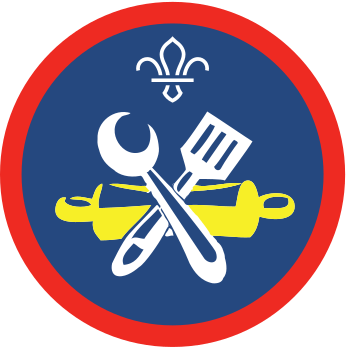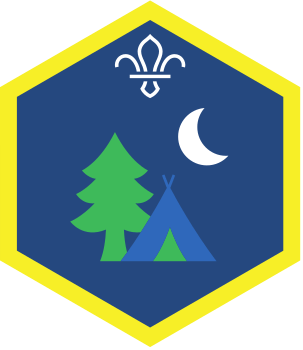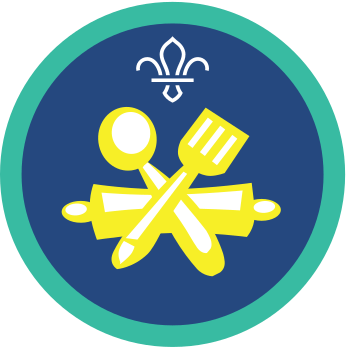
Plan your camp menu
You’ll need
- Pens or pencils
- Coloured pens or pencils
- A4 paper
- Device with access to the internet
- Recipe book, as needed
Before you begin
- Use the safety checklist to help you plan and risk assess your activity. Additional help to carry out your risk assessment.
- Make sure all young people and adults involved in the activity know how to take part safely.
- Make sure you’ll have enough adult helpers. You may need some parents and carers to help if you’re short on helpers.
Planning this activity
- This meal-planning activity is best run a few weeks before a camp, expedition or night away.
- Check for allergies, eating problems or dietary requirements and adjust the food items used as needed. This may include making sure there’s no cross-contamination during the storage, preparation, cooking and serving. If you’re unsure, check with the young person and their parents or carers.
- Be conscious about who may be fasting when running a food-related activity – you may want to plan it for when everyone can get involved.
- Write down some information about the campsite you’ll be going to and what facilities are available. Most sites will be happy to share this information about their facilities to make sure that your stay is comfortable.
- Download and print copies of the Allergens poster and Faiths and foods poster to help everyone with menu planning. You may also want to print off or make notes from our food safety and hygiene guidance.
Talk about the campsite
- Gather everyone together and tell them that they’re going to help decide on the menu for you next camp or Nights Away trip.
- Ask everyone to get into small groups, then collect some paper and pens.
- As a group, chat through the following questions based on the venue you’re going to. Make sure you know and have copies of the answers. Each group should make notes to help them plan the menu. The questions are:
- Do you have access to drinking water on site?
- Is there a kitchen facility for open use?
- Will this have storage facilities for your food items, or will you have to keep food in your own cool bags and containers throughout the camp?
- What equipment will you have access to for cooking?
- Are campfires or barbecues allowed and are there designated spots? Are they well-shielded from wind or do they have any rain cover?
- Is there anywhere to get firewood or does it need to be taken? This can help you work out how much of your own to bring along.
- Can underground ovens be made? You may need to ask the permission of the landowner or site manager if you want to dig holes for underground ovens.
Talk about inclusive menus
- Ask everyone what they think it means to be a ‘considerate’ cook. It means creating an inclusive, respectful menu that thinks about everyone’s needs.
- Explain that we all have different relationships with foods and drinks, so there are some things that need to be remembered when creating a menu. There are many reasons people may have different dietary requirements, such as personal preferences, food and food texture sensitivities, faiths, morals and beliefs, intolerances, medical reasons and allergies.
- Preferences are about liking or disliking certain foods, while requirements to do with faith or moral beliefs are about what people believe is right and wrong.
- Generally, intolerances cause uncomfortable symptoms, while allergies cause more serious immune system reactions.
- There are websites, such as Coeliac UK and Allergy UK, which are full of useful resources for specific needs.
- Remind everyone that food at camp is bound to be different from what you’re used to at home. It’s really important to keep an open mind and try new things, where possible. This could be how you find your next favourite food. However, some people may not like certain food textures or tastes and that’s OK, so we should try to find an alternative for them. No-one has to be made to try foods if they’re not happy, comfortable or don’t want to.
Making meal plans
- Ask everyone to get into their groups to design their menu.
- The person leading the activity should make clear the ingredients that cannot be included in the meal plan.
- Give each group printed or digital copies of the ‘Allergens poster’, ‘Eatwell guide’, ‘Faiths and food poster’ and the ‘Scouts quick tips for food safety’. They may also need some recipe books or a device with internet access.
- Now, you could either:
-
- Create meal plans, then ask each group to share their ideas and take the best ones to create an overall meal plan.
- Ask each group to create a meal plan for one day of camp. Each group should work on one at least one day’s worth of meals.
- Each group should make a grid to write the menu in, making sure to consider breakfast, lunch, dinner, snacks and drinks.
- Now, create the menu and add a meal idea for each mealtime and each day. You may need to consider how and where it’s cooked and eaten, as well as how long it takes.
- For older groups, groups could also include the prep time, cooking time, utensils needed and ingredients.
- Encourage everyone to think about different cooking methods, such as Dutch ovens or tinfoil parcels on a campfire.
- Each group should aim for each meal to be healthy, balanced and cater to everyone’s dietary needs.
- Remind groups that potential allergens may need to be prepared separately on different surfaces using different utensils, which may add some details to the meal plan.
- When each group feels they have completed their menu plans and equipment lists, an adult volunteer should check over the menus and offer feedback for any amends.
- When everyone is ready, gather back together.
- Someone from each group who is happy to should share their plans with everyone.
- Ask everyone to vote for their favourite options, then create a master menu plan. Alternatively, if each group is planning a day, bring all the menu items together and check it through as a group to make sure everyone is happy.
- You could all chat through where you might find their ingredients and how they’re going to be transported to the site, then stored them safely and hygienically.
Reflection
Learning to plan meals for one another is an important life skill that we can all take forwards and use every day. Planning and making our own meals helps us be more independent, understand about food hygiene, safety and preparation, and it may help us learn to budget.
You had to work together to create a menu. What did you enjoy? What was harder? Was it hard to agree on what you wanted or find appropriate recipes? How did you decide what to have for each meal? What other things did you have to consider and how did this impact your choices?
This activity also needed people to have good teamwork and communication. How did you communicate with others? Did you make sure everyone was listened to and had their voice heard? Did everyone contribute and share their ideas? Did any take the lead? How did you make your final choices or decisions? What went well and what could have gone better?
Did people take on different roles in the team? For example, did some people research recipes and other people check if they matched the group’s dietary needs?
Safety
All activities must be safely managed. You must complete a thorough risk assessment and take appropriate steps to reduce risk. Use the safety checklist to help you plan and risk assess your activity. Always get approval for the activity, and have suitable supervision and an InTouch process.
- Cooking
Teach young people how to use cooking equipment safely. Supervise them appropriately throughout. Make sure it’s safe to use and follow manufacturers’ guidelines for use.
- Food
Remember to check for allergies, eating problems, fasting or dietary requirements and adjust the recipe as needed. Make sure you’ve suitable areas for storing and preparing food and avoid cross contamination of different foods. Take a look at our guidance on food safety and hygiene.
- Fires and stoves
Make sure anyone using fires and stoves is doing so safely. Check that the equipment and area are suitable and have plenty of ventilation. Follow the gas safety guidance. Have a safe way to extinguish the fire in an emergency.
- Sharp objects
Teach young people how to use sharp objects safely. Supervise them appropriately throughout. Store all sharp objects securely, out of the reach of young people.
- Online safety
Supervise young people when they’re online and give them advice about staying safe. Take a look at our online safety or bullying guidance. The NSPCC offers more advice and guidance, too. If you want to know more about specific social networks and games, Childnet has information and safety tips for apps. You can also report anything that’s worried you online to the Child Exploitation and Online Protection Command. As always, if you’ve got concerns about a young person’s welfare, including their online experiences, follow the Yellow Card to make a report.
- If anyone’s working towards the Scouts Chef Activity Badge, remind them that their meal plan should be for between four and six people to meet the requirement for that badge.
- If anyone’s working towards the Scouts Camper Activity Badge, their plans need to be for a trip with campfire cooking.
- Check for allergies, eating problems or dietary requirements and adjust the food items used as needed. This may include making sure there’s no cross-contamination during the storage, preparation, cooking and serving. If you’re unsure, check with the young person and their parents or carers.
- If someone needs different food items, such as gluten free biscuits, you may want to buy these for the whole group.
- Whenever you’re talking about food, remember that everyone’s situations will be different. Some households may be able to easily afford to buy any food they like, whereas others may rely on help from food banks or have fewer choices at the supermarket.
- What we eat at home can vary greatly from household to household. It’s important to be sensitive to the fact that many young people might not be aware of certain ingredients, equipment or cooking jargon.
- Food may be a difficult for lots of people. We all have a relationship with food and eating, and sometimes this can affect our mental health. Anyone can develop an eating disorder, whatever their age, gender or cultural background. Take a look at our guidance on eating disorders.
- Be aware of your group’s needs and safeguarding requirements. Make sure you look out for these individuals and provide a safe and calm space for them to process their emotions. Always follow the Yellow Card.
- People who struggle with making choices could find all the options a bit overwhelming, so they might need extra support. People could work in pairs or small groups to come up with ideas or make decisions. You could have a whole group discussion before letting people make a decision, as this might help people think of ideas or choose the best option for them. A young leader or volunteer to be able to help them to choose or make a decision, too.
- If people may struggle to think of ideas or make a decision, you could have a ready-made list of ideas for people to use and pick from. It might inspire another idea. Make sure that any suggestions that are suitable for everyone.
All Scout activities should be inclusive and accessible.
When you get to camp or your Nights Away event, the groups can cook the recipes you’ve all planned to help everyone work towards other badges.




